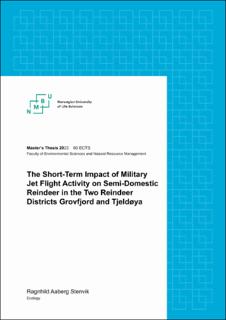| dc.description.abstract | Rangifer tarandus (hereby referred to as reindeer) are a migratory species with a diet changing throughout the year, and survival and reproduction depend on access to, and time for optimal grazing. Reindeer can be disturbed by anthropogenic activities, like aircraft activity, construction of roads and outdoor recreation. Such disturbances may change their migration route, delay their arrival at new grazing areas, increase grazing in less optimal areas or reduce time spent foraging.
A two-year study, starting in June 2021, experimentally tested the effects of jet flight activity on reindeer in two test and two control groups within the reindeer herding districts Grovfjord and Tjeldøya. Fieldwork in June 2021, September 2021 and September 2022 tested two models of jets, the F-16 and the new F-35, by registering the test reindeers’ behaviour as aircrafts passed them. Control animals, i.e. animals that were not exposed to the jets, were also registered. Video cameras and binoculars were used to register the animals’ reactions.
In Grovfjord, the majority of the test reindeer reacted clearly by either changing their behaviour or abruptly looking up while grazing (i.e. vigilance). At Tjeldøya, there was no difference between the number of test reindeer reacting clearly or not. The test animals overall showed a high level of vigilance in both districts. For both clear/unclear reaction and vigilance, none of the control animals in either district changed their behaviour over time. When analysing 60 seconds of “maximum overflight”, control animals in Grovfjord show a high level of relaxed behaviour like lying and grazing, while the test animals show a high level of ‘stressed’ behaviour, like standing, walking and running. At Tjeldøya, results were unpredictable, with more ‘walking’ in the control group than anticipated. During the test period, reindeer on average stressed the most approximately 17-25 seconds into the minute and relaxed after that. An analysis including sound measurements showed that noise levels did not have a significant effect on the reindeer’s reactions. Reindeer reactions were probably influenced by a mix of different factors, and not just the noise, such as movement, surroundings and more. | |
